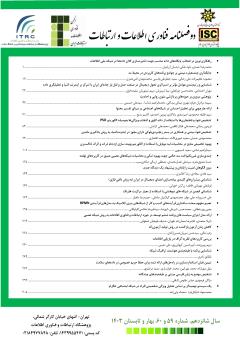شناسایی پیشرانهای کلیدی پیادهسازی امضای دیجیتال در ایران (به روش دلفی فازی)
محورهای موضوعی : جامعه الکترونیکی
قربانعلی مهربانی
1
![]() ,
فاطمه زرگران خوزانی
2
,
فاطمه زرگران خوزانی
2
![]()
1 - گروه مدیریت راهبردی، دانشگاه مدیریت، دانشگاه دفاع ملی، تهران، ایران
2 - گروه مدیریت بازرگانی، دانشگاه مدیریت و حسابداری، دانشگاه علامه طباطبائی
کلید واژه: امضای دیجیتال, تحول دیجیتال, دلفی فازی, امنیت اطلاعات, احراز هویت,
چکیده مقاله :
هدف این مقاله، شناسایی و واکاوی پیشرانهای کلیدی پیادهسازی امضای دیجیتال در ایران با رویکرد دلفی فازی است. پژوهش ازنظر هدف کاربردی و ازلحاظ گردآوری اطلاعات، از رویکرد فراترکیب بهره برده است. جامعه آماری را کلیه خبرگان و متخصصان حوزه فناوری اطلاعات و امضای دیجیتال و مقالات این حوزه تشکیل میدهند. حجم نمونه جامعه آماری خبرگان 13 نفر است که با روش نمونهگیری هدفمند انتخاب شدند. مقالات نیز براساس در دسترس و دانلودبودن، غیرفنی بودن و مرتبط بودن با موضوع تعداد 30 مقاله انتخاب شد. روش تحلیل دادهها با توجه به رویکرد دلفی فازی انجام شد. روایی و پایایی به ترتیب با استفاده از شاخص CVR و آزمون کاپای کوهن با ضریب 83/0 و 93/0 محاسبه و تائید شد. نتایج گواه این است که پیشرانهای کلیدی پیادهسازی امضای دیجیتال در ایران شامل 5 بعد اصلی و 30 مفهوم است که عبارتاند از 1) امنیتی (محرمانگی اطلاعات، امنیت اطلاعات، احراز هویت فرستنده، احراز هویت سند، حفظ حریم خصوصی، اعتماد میان طرفین)، 2) کسبوکاری (مدلهای کسبوکار دیجیتال، نیازهای ارتباطی سریع، مدیریت کارکنان عملیاتی، اندازه سازمان، ساختار سازمانی، منابع سازمان، فرهنگسازمانی، مدیران ارشد، اکوسیستم رقابت، حکمرانی الکترونیک)، 3) کاربری (سهولت درک شده، منفعت درک شده، رفتار مصرفکننده، سواد مصرفکننده، سبک زندگی مصرفکننده)، 4) فنی (توسعه زیرساختهای فنی، یکپارچگی سیستمها، پیچیدگی سیستمی، باکهای سیستمی، کیفیت طراحی، سرعت فنی تولید و تائید گواهی، نفوذناپذیری هکرها) و 5) قانونی (مجوزهای قانونی، قوانین مجازاتی، نهاد قانونگذار، قوانین تجارت الکترونیک).
iThe purpose of this article is to identify and analyze the key drivers of digital signature implementation in Iran with a fuzzy Delphi approach. In terms of practical purpose and in terms of information gathering, the research has benefited from a hybrid approach. The statistical community consists of all experts and specialists in the field of information technology and digital signature and articles in this field. The sample size of the statistical community of experts is 13 people who were selected by the purposeful sampling method. 30 articles were selected based on their availability and downloadable, non-technical nature, and relevance to the topic. The method of data analysis was done according to the fuzzy Delphi approach. Validity and reliability were calculated and confirmed using the CVR index and Cohen's kappa test with coefficients of 0.83 and 0.93, respectively. The results prove that the key drivers of digital signature implementation in Iran include 5 main dimensions and 30 concepts, which are 1) security (information confidentiality, information security, sender authentication, document authentication, privacy protection, trust between parties), 2) business (digital business models, communication needs, staff management, organization size, organizational structure, organization resources, organizational culture, top managers, competition ecosystem, e-governance), 3) user (perceived convenience, perceived benefit, consumer behavior, consumer literacy, consumer lifestyle), 4) technical (development of technical infrastructure, systems integration, system complexity, system tanks, design quality, technical speed of certificate production and verification, impermeability of hackers) and 5) Legal (legal licenses, penal laws, legislative body, e-commerce laws).
